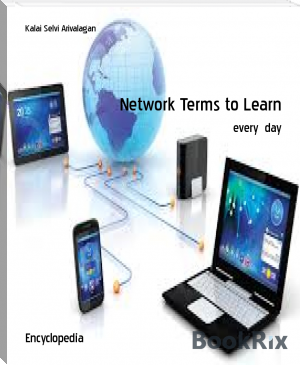Network Terms to Learn - Kalai Selvi Arivalagan (best love novels of all time .TXT) 📗

- Author: Kalai Selvi Arivalagan
Book online «Network Terms to Learn - Kalai Selvi Arivalagan (best love novels of all time .TXT) 📗». Author Kalai Selvi Arivalagan
Structured Data
Structured data are data that are organized in a format easily used by a database or other technology.
Unstructured Data
Unstructured data represents any data that does not have a recognizable structure. It is unorganized and raw and can be non-textual or textual. For example, email is a fine illustration of unstructured textual data. It includes time, date, recipient and sender details and subject, etc., but an email body remains unstructured. Unstructured data also may be identified as loosely structured data, wherein the data sources include a structure, but not all data in a data set follow the same structure. In customer-centered businesses, the data found in an unstructured form may be examined to enhance relationship marketing and customer relationship management (CRM). As social media apps, such as Facebook and Twitter, go mainstream, unstructured data development is likely to outrun the progress of structured data.
Data Aggregation
Data aggregation is a type of data and information mining process where data is searched, gathered and presented in a report-based, summarized format to achieve specific business objectives or processes and/or conduct human analysis. Data aggregation may be performed manually or through specialized software.
Ad Hoc Analysis
A cloud database is a type of database service that is built, deployed and delivered through a cloud platform. It is primarily a cloud Platform as a Service (PaaS) delivery model that allows organizations, end users and their applications to store, manage and retrieve data from the cloud.
Massively Parallel Processing
Massively parallel processing (MPP) is a form of collaborative processing of the same program by two or more processors. Each processor handles different threads of the program, and each processor itself has its own operating system and dedicated memory. A messaging interface is required to allow the different processors involved in the MPP to arrange thread handling. Sometimes, an application may be handled by thousands of processors working collaboratively on the application.
Decryption
Decryption is the process of transforming data that has been rendered unreadable through encryption back to its unencrypted form. In decryption, the system extracts and converts the garbled data and transforms it to texts and images that are easily understandable not only by the reader but also by the system. Decryption may be accomplished manually or automatically. It may also be performed with a set of keys or passwords.
Steganography
Steganography is data hidden within data. Steganography is an encryption technique that can be used along with cryptography as an extra-secure method in which to protect data. Steganography techniques can be applied to images, a video file or an audio file. Typically, however, steganography is written in characters including hash marking, but its usage within images is also common. At any rate, steganography protects from pirating copyrighted materials as well as aiding in unauthorized viewing.
Passive Biometrics
In passive biometrics, systems are able to authenticate a user without any explicit user activity or input. This is often done through a diversity of passive inputs, including data sets that are generated by monitoring the user in real time.
Hyperautomation
The term "hyperautomation" is relatively new and generally refers to new techniques and methods that can automate processes in significant and profound ways. Although the term is not clearly defined on many of the encyclopedia resources that people generally use online to figure out common usage for new terms, bodies like Gartner and big companies in the tech space are defining hyperautomation as the next wave of automation or “automation 2.0.”
Cloud Encryption Gateway
A cloud encryption gateway is a technology that provides point-of-process encryption for data traveling to and from a cloud environment. It is a tool that sits between a cloud system and an in-house system, and performs encryption or tokenization of data in transit. The resulting "shielded" data can then be used safely by software-as-a-service (SaaS) applications.
AI Strategist
An AI strategist is an IT professional whose role deals with the evolution and application of artificial intelligence products and services.
Change Management
Change management is an IT services management (ITSM) strategy in which a systematic approach ensures the efficient and seamless flow of change in an organization's IT infrastructure. Change management helps all involved parties, including both individuals and teams, to move from a current state to the next desired state. Change management also helps to minimize the impact of related incidents on service. Change is prevalent in any IT organization and it may arise reactively in response to problems or be externally imposed. Change management is also a project management process where change requires formal adherence to established policies.
ABAP Objects
ABAP Objects are the object-oriented extension introduced in 1999 to the original ABAP (Advanced Business Application programming) language and ABAP Workbench from R/3 release 4.6 and on. This fully integrated extension endows ABAP with object-oriented features for the design and implementation of object-oriented programs. Programs in ABAP may or may not contain ABAP Objects, at the programmer’s discretion.
Lamport's Bakery Algorithm
Lamport’s bakery algorithm is a computing algorithm that ensures efficient use of shared resources in a multithreaded environment. This algorithm was conceived by Leslie Lamport and was inspired by the first-come-first-served, or first-in-first-out (FIFO), operational methodology of a bakery. Lamport’s bakery algorithm is a mutual exclusion algorithm that restricts two or more processes from accessing a resource simultaneously.
Internet of Everything (IoE)
The internet of everything (IoE) is a broad term that refers to devices and consumer products connected to the internet and outfitted with expanded digital features. It is a philosophy in which technology's future is comprised of many different types of appliances, devices and items connected to the global internet. The term is somewhat synonymous with the internet of things (IoT).
Online Marketing
Online marketing is a set of tools and methodologies used for promoting products and services through the internet. Online marketing includes a wider range of marketing elements than traditional business marketing due to the extra channels and marketing mechanisms available on the internet.
Online marketing can deliver benefits such as:
Growth in potential
Reduced expenses
Elegant communications
Better control
Improved customer service
Competitive advantage
Online marketing is also known as internet marketing, web marketing, or digital marketing. It includes several branches such as social media marketing (SMM), search engine optimization (SEO), pay-per-click advertising (PPC), and search engine marketing (SEM).
Term of the day - 31 Chief Data Officer (CDO)
A chief data officer (CDO) is a senior executive role in an organization that is responsible for data governance throughout the organization. Although related, the roles of the CDO and the chief information officer are different. The CDO typically reports to the chief technology officer (CTO), chief operating officer (COO) or the chief executive officer (CEO).
The CDO is responsible for a number of areas encompassed by data governance such as:
Chief Risk Officer (CRO)
A chief risk officer (CRO) is an executive- or senior-level position within a company. The chief risk officer is responsible for analyzing and governing that company's risk. They are responsible for evaluating IT security as well as other potential threats to business.
Turing Complete
A system is said to be "Turing complete" in computer theory if it can be used to emulate a Turing machine, which is a theoretical construct designed by mid-century mathematician and computer scientist Alan Turing.
Security Manager
In IT, a security manager can be a piece of software, a platform or a person that takes on security management tasks.
Bidirectional Search
Bidirectional search is a type of search and sort activity that combines two directional approaches, so that the generator in question searches in two directions at the same time. Using this method can decrease the amount of search activity needed to achieve a particular result.
Ethical Hacker
An ethical hacker is an individual hired to hack into a system to identify and repair potential vulnerabilities, effectively preventing exploitation by malicious hackers. They are security experts that specialize in the penetration testing (pen-testing) of computer and software systems for the purpose of evaluating, strengthening and improving security. An ethical hacker is also known as a white hat hacker, red team, tiger team or sneaker.
Security Operations Center
A Security Operations Center (SOC) is a strategic command center facility for fighting cyberattacks through monitoring, threat analysis and more. The implication is that the SOC is generally a physical location in which to house professionals and cybersecurity assets.
Security by Design
Security by design (or secure by design), sometimes abbreviated "SbD," is a new industry term for a range of security practices built on one fundamental idea — that security should be built into a product by design, instead of being added on later by third-party products and services.
Chief Medical Information Officer
A chief medical information officer (CMIO) is a healthcare executive who is responsible for managing the health informatics platform and working with clinical IT staff for supporting efficient design, implementation and usage of healthcare technologies. It is a relatively new role in the healthcare space. A chief medical information officer is also known as a chief medical informatics officer, chief clinical information officer, director of medical informatics or director of health informatics.
Rectified Linear Unit
The rectified linear unit (ReLU) is one of the most common activation functions in machine learning models. As a component of an artificial neuron in artificial neural networks (ANN), the activation function is responsible for processing weighted inputs and helping to deliver an output.
Data Annotation
Data annotation is a term to describe the labeling of data. Different types of data get annotated in different ways. Text strings can be labeled with various common annotations, where image data is often annotated with colored lines or other markers.
Ryuk Ransomware
Ryuk ransomware is a type of ransomware attack where encryption is used to steal away data which will only be a returned in exchange for a ransom. Ryuk ransomware spreads through malware and infects systems in ways that are difficult to analyze because certain aspects of the code are deleted after execution.
Systems Analyst
A systems analyst is an IT professional who works on a high level in an organization to ensure that systems, infrastructures and computer systems are functioning as effectively and efficiently as possible. System analysts carry the responsibilities of researching problems, finding solutions, recommending courses of actions and coordinating with stakeholders in order to meet specified requirements. They study the current system, procedures and business processes of a company and create action plans based on the requirements set.
NeuroEvolution of Augmenting Topologies
NeuroEvolution of Augmenting Topologies or NEAT is often described as a genetic solution for improving neural networks. The NEAT concept can be used to provide a new model for selecting typologies for a neural network and for initializing weights.
Closed-Loop Control System
A closed-loop control system refers to a hardware or logical setup that regulates a process variable and automatically keeps a process to a desired state, according to inputs. The alternative is an open-loop control system.
Linear Programming
Linear programming is a mathematical method that is used to determine the best possible outcome or solution from a given set of parameters or list of requirements, which are represented in the form of linear relationships. It is most often used in computer modeling or simulation in order to find the best solution in allocating finite resources such





Comments (0)